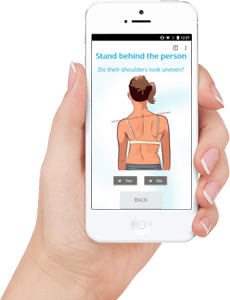Over the last few weeks, we have been looking at scoliosis – a potentially serious condition which affects between 3% and 4% of children and as many as 40% of the over 60’s. As we have discussed already, scoliosis can be tricky to spot – and if let untreated tends to become more serious. Screening for scoliosis is however, easy and fast to do – in fact, you can do it at home right now.
This week lets look at how to screen for scoliosis, and what you can do to mitigate your risk.
How to screen for scoliosis at home
The simplest way to screen for scoliosis is using our guided screening tool, scoliscreen. Scoliscreen will lead you through the steps of screening and can give you an indication as to your risk, based on your responses. You can also screen using the following steps:
The best way to check for scoliosis is have the person wear their underwear or swimwear. Stand behind them and check for –
- Are the shoulder’s level or uneven?
- Is the waist even on each side? Or is one side straighter and the other more rounded or prominent?
- Does one side look like it’s folded down or have a large skin crease?
- Are the shoulder blades level? Does one stick out more than the other?
- With straight legs, have them bend forward from the waist and put their hands between their knee’s if possible.
Look to see if one side of the rib cage is higher than the other or the lower back is more prominent than the other. This is a check for spinal rotation.
Scoliosis – Managing the risk
Since scoliosis is thought to have at least some genetic component, and with the fact that 80% of cases are idiopathic in mind, there isn’t a huge amount that individuals can do as a preventative mechanism, although by being vigilant for the development of scoliosis you can be sure to catch a developing case early, and therefore increase the chances of successful treatment.
That being said, there has been speculation about various methods to avoid scoliosis, lets take a quick look at some here:
Does swimming prevent Scoliosis?
For some time, children were told to swim to treat scoliosis. While swimming is a great form of exercise in general, there is no evidence to support it as a treatment or prevention for scoliosis – although there has actually been some research which suggests that scoliosis can be worsened after swimming. This research is not strong enough to suggest that scoliosis patients should avoid swimming, but we can now say that swimming alone is not an effective treatment.
Does good posture reduce my chance of scoliosis?
You might think that poor posture might encourage the development of scoliosis– this makes sense, since often adolescents in particular will have slumping posture. Adolescents are those most often treated for scoliosis – however there is no evidence that posture causes scoliosis.
Can you correct Scoliosis by just sitting up straight?
Scoliosis is more than just twisting of the spine – it’s cause is often multifactorial; thus, a multifactorial treatment must be given. Sitting up straight might help a little, since postural exercises might well be an effective element of a treatment program, but the right treatment will be different for every patient – that’s why we take time to go through a detailed consultation process with each patient.
Does ballet or gymnastics cause scoliosis?
There does seem to be a connection between forms of sport an exercise which involve significant contortion of the body, and scoliosis. Significantly higher than average rates of scoliosis have been observed amongst participants in certain activities – ballet dancers, gymnasts and dancers are thought to be as much as 12 times more likely to develop scoliosis.[i] Having said this, it is also the case that individuals involved in these activities, as well as clubs and organisations, are more aware of scoliosis in the first instance. It’s likely that there is some link, but the correct way to address this is with regular screening, not abandoning the sport you enjoy.
Can I prevent scoliosis?
While there does not seem to be any way to lower your risk of developing scoliosis in the first place, you certainly can do a lot to lower your risk if scoliosis progressing to the point that it impacts on your everyday life or requires surgery. Frequent scoliosis screening is recommended for at risk individuals, including those participating in activities such as ballet. When scoliosis is caught early, it can usually be easily treated with conservative, non-invasive methods for little or no long term effect.
I’m concerned about scoliosis, what should I do?
If you have concerns about scoliosis, or show a high risk during a screening the best course of action is to book a specialist consultation a soon as possible. Just call the clinic today and we’ll arrange a scoliosis consultation for you. Scoliosis can only be formally diagnosed and treated by a scoliosis expert, so while we wouldn’t encourage you to avoid your GP, it’s worth attending a scoliosis specific consultation first. A scoliosis consultation can tell you definitively if you do have scoliosis, and what the best treatment options are for you.
[i]‘Prevalence and predictors of adolescent idiopathic scoliosis in adolescent ballet dancers’
Longworth B., Fary R., Hopper D, Arch Phys Med Rehabil. 2014 Sep;95(9):1725-30. doi: 10.1016/j.apmr.2014.02.027. Epub 2014 Mar 21.

